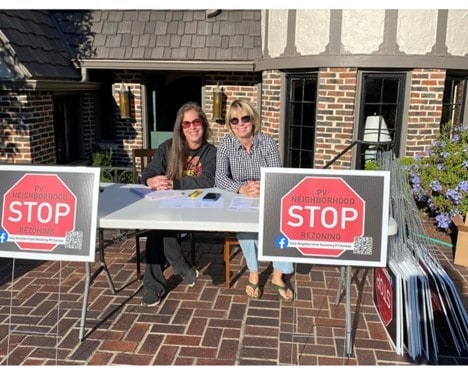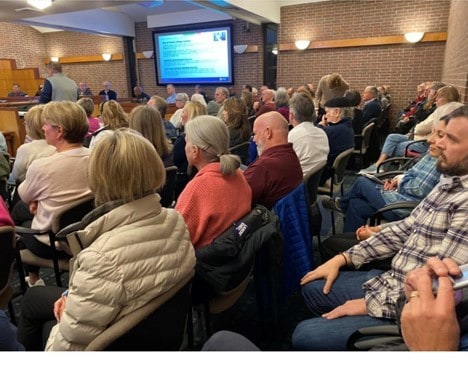Discussions on changing zoning regulations to to strip homeowners of property rights to increase the supply of more affordable housing in Prairie Village has left more questions than answers, according to some homeowners in the Johnson County community.
 Addressing sky-rocketing housing prices is the goal of the city’s ad-hoc housing committee.
Addressing sky-rocketing housing prices is the goal of the city’s ad-hoc housing committee.
The committee’s strategies are three-fold:
- Amend Prairie Village zoning regulations in a way that allows attainable housing to be built in more zoning districts, specifically missing middle housing.
- The zoning regulations would allow, potentially, for accessory dwelling units, courtyard patterns or row houses.
- Support rehabilitation of the city’s existing housing stock in an effort to preserve its existing attainable housing options.
- Some specific methods for this include raising the income threshold for the property tax rebate program and increasing the percentage match for the exterior home grant program.
- Keep participating in regional initiatives about housing attainability and transit connectivity.
Under direction of City Council, the committee was guided by the 2021 Johnson County Community Housing Study.
The study looked into the future of PV’s housing needs through 2030:
Prairie Village has an average annual construction need of 434 units through 2030, with 224 units being net new units likely in the form of denser mixed-use redevelopment in commercial corridors. The average gross annual construction rate from 2010 to 2019 was 66 units, with a high of 312 in 2016 and a low of 3 in 2012. However, an average of 31 units were demolished per year in this time frame, most having rebuilds on the same lot. The net annual construction rate was 36 units when subtracting units demolished.
- Approximately 144 owner-occupied units should be priced below $250,000.
- About 67 rental units will need to be produced with rents below $1,000 per month, through a variety of programs.
Mayor Eric Mikkelson says the city’s focus on zoning reform to increase housing stock and reduce costs has middle-class home buyers in mind:
“Historically, a Prairie Village residence and way of life has been attainable by middle-income working professionals (teachers, nurses, cops, shop workers, etc.) as well as the more affluent. As our home value increases continue to significantly outpace wage increases, that part of our civic character is changing.
“If the Planning Commission and/or Council bring forward specific proposed responsive policy changes following that public input, my metrics for evaluating any such proposals will include: Do they help conserve that part of the Prairie Village way of life that has been attainable by middle-income working professionals? Do they also support strong neighborhoods, safety, and economic prosperity?”
Homeowner Lori Sharp questions the city’s reform motives:
“PV just got their appraisals back. We went up average 17%.
However the city is looking at a $40-50 million dollar civic center. They would tear down the current YMCA, build a new Y and then let the Y run it. All on the PV taxpayers’ dime. Plus, the mayor would get a building with his name on it!
“On top of this, they are considering adding full time health benefits to the current city council members. This is a part time volunteer job, at best. This would add another $300,000 to the city budget. So, their desire to have “affordable” housing is suspect as best. They just want more tax revenue to pay for all their projects!”
PV City Council makes housing less affordable
Sharp’s point is reflected in city officials having imposed unnecessary property tax hikes that far outpaced inflation and population growth in the last quarter-century. City Council members have voted to increase property tax revenue by 245% since 1997, which is 3.5 times the combined rates of inflation and population growth. Population has stagnated over the last 25 years, recording a 3% decline.

Ironically, Prairie Village City Council members are partially to blame for housing being less affordable because property tax is a major component of mortgage payments. And they are poised to make it worse. Unless Mayor Eric Mikkelson and other council members call for a significant reduction in the mill rate, they will use the 17% increase in residential appraisals to impose a double-digit property tax increase.
Property rights: two wrongs don’t make a right
Homeowner Jan Bleakley, in a lengthy letter to the PV Planning Commission, suggested a political overtone to reform efforts:
“Unfortunately, there continues to exist a push by a few to make this about racism, exclusion and reconciliation. Regardless of its place in the national spotlight, for Prairie Village, we believe this issue should not be distracted by calls for social justice. It is simply too fundamental for political posturing.”
Bleakley went on to warn city officials not to “overreact with trendy zoning and planning ideas.”:
“Those who believe that supporting new zoning regulations will finally rid Prairie Village of the stain of JC Nichols, don’t choose to understand the reality of what for years has made ours a great community. Designated single family and multi-family neighborhoods, walkability to clearly-defined shopping/business districts, schools and houses of worship prove the desirability and long-term viability of our current zoning regulations. Good planning is color blind. Good planning includes affordability, as currently exists in Prairie Village. And good zoning promotes citizen participation. It’s time to focus on workable solutions.”
 One of the most controversial proposals of the Planning Commission is to impose “By-Right” zoning, which strips homeowners of the property rights. Currently, homeowners who object to private development plans have a right to legal notice, have a public hearing, the right to oppose a submitted plan, and their right to file a protest petition. Bleakley’s letter notes that these stakeholder’s property rights have successfully led to “better development” for neighborhoods and that Mayor Mikkelson supported at least one of those efforts.
One of the most controversial proposals of the Planning Commission is to impose “By-Right” zoning, which strips homeowners of the property rights. Currently, homeowners who object to private development plans have a right to legal notice, have a public hearing, the right to oppose a submitted plan, and their right to file a protest petition. Bleakley’s letter notes that these stakeholder’s property rights have successfully led to “better development” for neighborhoods and that Mayor Mikkelson supported at least one of those efforts.
Homeowner and nurse Karen Gibbons is critical of the city’s transparency on the reform issue:
“The City Council’s comments are a moving target. They have never answered a list of questions we submitted months ago. They answer according to their audience. Even the Prairie Village Planning Commission has asked for clarification. Murky plans make it hard to debate their actions, just as they intend.”
Dan Schoepf, spokesman for the homeowner’s organization PV United, echoes Gibbon’s assessment:
“In summary our concerns can be capsulized in two words: Unanswered questions.”
Schoepf says he presented the following questions to the city in December, but has yet to hear a response:
- What are the goals and anticipated outcomes for changing a zoning process that has worked for many years?
- What is the definition of success if a zoning change should be made?
- Did the city conduct a thorough review of where these proposed changes are legal? If so, where is that documentation? If not, why not?
- Did the city council obtain legal advice on the recommended zoning changes before it was unanimously approved to send it to PC for “implementation”? If so, please share the findings and where they are published as part of the minutes/discussion?
- Have the council members met with residents in their respective Wards to seek formal feedback? If so, where is this information? If not, why not?
- Median income determination…why weren’t the Prairie Village AMI figures used in Village Vision vs the KC Metro Median Income?
PV AMI=$88,200
KC Metro=$73,900
Kansas City, MO=$63,400
Kansas City, KS=$53,900
(source: https://censusreporter.org/) - The Ad hoc committee assumed there is a shortage of housing for a specified group of individuals. What sources were used to come to this conclusion?
- Assuming the objective is to increase diversity in Prairie Village (Disclaimer—Is that one of the objectives?) How would the city control who moves in by race, religion and how much developers will charge?
- “By right” is a clause that removes the opportunity for citizen input in development. How does this increase property owners’ rights?
Mayor Mikkelson disputes claims of a lack of transparency and accountability, and says public outreach by the city is proof all voices are being heard:
“We are listening carefully to feedback from residents on how best to address housing cost challenges in Prairie Village. We are scheduling a series of public-input forums focused on potential solutions in existing multi-family and commercial zoning districts in Prairie Village.
“I am optimistic that through this extensive public engagement process we will find tailored solutions for our community that accomplish all of these.”
Those words ring hollow, however, based on the actions of City Council and the Planning Commission.
The mayor added research by the Kansas Policy Institute, parent company of the The Sentinel, endorses zoning reform as a way to reduce housing costs, but citing that as justification is quite the opposite of transparency and accountability. Kansas Policy Institute cited specific examples of zoning reform to protect property rights:
“…zoning has long been abused to separate people arbitrarily. For instance, African-American neighborhoods in St. Louis were re-zoned from commercial areas to industrial zones to justify lower public services. The process by which African-American-owned homes near white neighborhoods were drawn into new zones contributed to redlining. This happens in Kansas City as well: zoning practices that labeled some neighborhoods as good and some as bad.”
PV City Council has scheduled a Work Session to discuss this issue again on April 24, and the Sentinel will be there to see if city officials decide to honor homeowners’ property rights.




